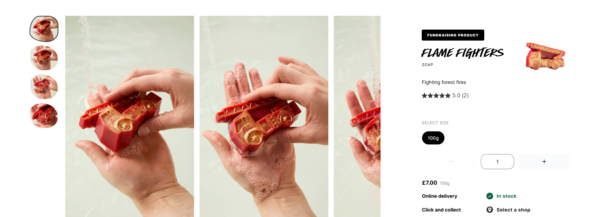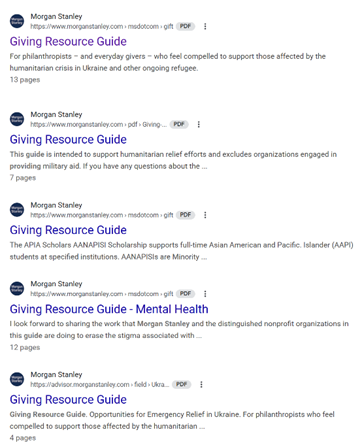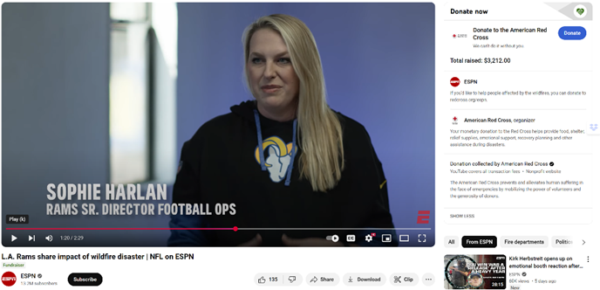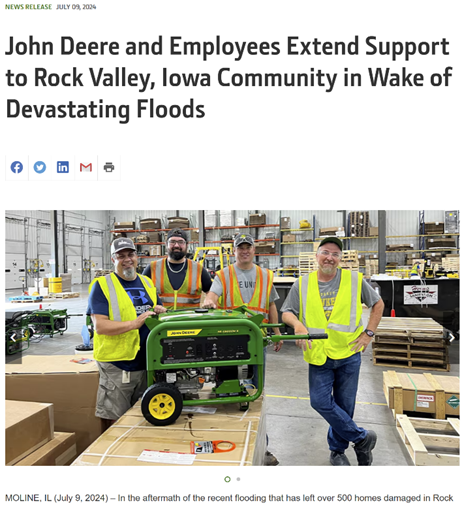Many brands line up with statements of “thoughts and prayers” after natural and human-made devastation, such as the recent California wildfires and hurricane flooding in western North Carolina.
Interestingly, though, that expression emphasizes their silent response.
However, brands that truly want to help the people who suffered tragedy know they must activate a response plan. But how and why?
Marketers should be on the frontline of the brand response. By working with others in your organization and external partners, you can turn those thoughts and prayers into helpful actions. Here are eight brands doing just that.
1. Assist with relevant products and services: Meade Tractor
Take a brief but important pause to reflect on what your brand does. This may seem like an unnecessary step, but when a disaster strikes, well-intentioned people in your organization may want to throw business to the side and put everything into a humanitarian response.
You can lead the conversation to emphasize that your company can do both — fulfill its business mission and lend a helping hand. That dual purpose also creates a relevancy that enables the business to tell the stories for months (and years) to come through its marketing channels.
In some situations, it’s easy to see how to do both. For example, Meade Tractor sells farm and construction equipment — the kind of products needed when the floods hit western North Carolina and southwest Virginia, where it has stores.
Its crisis response included loaning agricultural and compact construction equipment to individual farmers. “By supporting our farmers in times of need, we reaffirm our dedication to making a positive impact when it matters most,” the company wrote on the rental equipment application page.
So, if your business’ products and services can help, do it and tell that story.
2. Repurpose your charitable work: Lush
What if your brand doesn’t sell products or services that can help in the crisis, like Lush, a U.K.-based bath and beauty product company?
Last November, Lush launched a fire-truck-shaped soap in the United Kingdom and Europe to raise money for Indigenous and community volunteer fire brigades in the Amazon. When the Los Angeles wildfires happened, Lush sold the soap product in the United States and designated 75% of U.S. sales to emergency aid for people and animals affected by the fires.

What charitable activities does your company already do? If you don’t sell a product for charity or raise money for a designated nonprofit, is there a local organization where your employees volunteer? Consider reconfiguring or complementing those efforts for the most recent disaster response.
3. Help your social audience: Josie Maran
If donating products or profits isn’t feasible, turn to something that marketing has built — your brand’s audiences on social media.
In an immediate response to the southern California wildfires, entrepreneur and beauty brand Josie Maran replaced its normally product-focused Instagram posts with this carousel post sharing community resources to help those affected:
Posting this type of information is also likely to motivate your audience to share with their audiences and spark comments from people offering additional resources.
4. Craft a useful resource: Morgan Stanley
Morgan Stanley provides a wealth of resources for its philanthropic clients and communities. It publishes guides for causes ranging from the humanitarian crisis in Ukraine and military aid organizations to children’s mental health and scholarships for students.

When the Los Angeles wildfires broke out, the financial services firm created the 12-page Giving Resource Guide: Southern California Wildfire Relief. As Morgan Stanley does with its other guides, this version outlines 14 relevant organizations, detailing their missions, responses to the crisis, and donation-related links in the PDF.
Guides or resource lists work well when distributed to relevant segments of your email lists. Publishing them on your website can also lead people using search engines to discover the resources (that’s how I found out about Morgan Stanley’s work). You also can promote and link to them from your social media channels.
5. Tell a relevant story and partner on the CTA: ESPN
ESPN expanded its content lineup to tell sports stories related to the wildfires, including this video interviewing the National Football League’s Los Angeles Rams. The players saw the smoke from their practice facility and employees of the organization had homes in the scorched neighborhoods.
ESPN devoted the text on the video’s YouTube page with CTAs for the American Red Cross, featuring a donate button and a tally of the total amount raised.

You can probably get this type of response approved most easily because the storytelling fits the brand’s mission and does not require the company itself to make a financial donation.
6. Tell employee stories: John Deere
If your brand operates or sells in a disaster area, chances are your employees are affected by it, too. Tell their stories (with permission, of course).
For example, when flooding damaged over 500 homes in Rock Valley, Iowa, John Deere shared how local employees volunteered their time to help and detailed the donations both employees and the brand were giving.

The post noted how employees covered for colleagues directly affected by the flood. It also shared links to a local charitable organization for people who wanted to donate.
7. Form a coalition: Los Angeles: Beauty Together
When the fires hit southern California, Josie Maran did more than post helpful resources on the brand’s Instagram channel. She got over 30 brands to form a charitable fund — Los Angeles: Beauty Together — with the mission “to provide relief to those who have lost everything to the tragic events in Los Angeles.”
While that’s the immediate purpose, Josie also knows the effort can’t be short term. Phase two will encompass sustained support to victims and charitable service providers over the rebuilding process. “This is a long healing road,” Josie tells People magazine.
8. Plan for the long term: Joey Logano Foundation
NASCAR driver Joey Logano talked last fall after Hurricane Helene about the importance of taking the long view with his foundation’s help.
“The only way you can (help) correctly is to be there and see it and say, ‘OK, where are things doing pretty good and where are things lacking and how do we look three months, six months, a year ahead and put a plan together?’”
Though you may not know yet what your brand’s long-term support will look like, you can take steps now to plan for the follow up. For example, add entries to your content calendar and fill in the specific angles or topics later.
Lead the charitable response
Turning thoughts and prayers into action is a strategy made for marketers. You have already worked hard to build goodwill and trust with your audience so they’ll ultimately take a profitable action with your business. Now, you can take that one step further and help your brand and audience to take an action that will be profitable to those affected by disasters.
HANDPICKED RELATED CONTENT:
Cover image by Joseph Kalinowski/Content Marketing Institute
